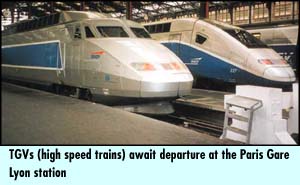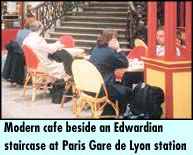 |
 6th June 1999 |
Front Page| |
Royston Ellis samples train travel at its bestSmooth dash
Comparing travel on France's TGV to flying is appropriate. TGV stands for "train a grande vitesse" which is the name for this French high speed train. In 1990 a TGV broke the world speed record, reaching a speed of 320.20 miles an hour, which is about half that of a passenger jet aircraft, on a stretch of track near Tours. As I set in my first class seat on TGV number 973 at the Paris station, Gare de Lyon, I reached instinctively for the seat belt. There wasn't one. None of the other passengers travelling on the train to Geneva looked excited at the prospect of such a high-speed experience. In France, fast trains that glide at great speeds along well-kept rail tracks are commonplace. The TGV is an electrically powered train, produced by France, that provides the world's fastest rail service. It began operating first in 1981 and within 10 years had carried more than one million passengers. Every day six TGVs link Paris with Geneva and there are now TGV services throughout France, as well as linking Brussels with Nice. I was bound for Geneva and armed with a computer generated billet that resembled an airline ticket. It was enclosed in a wallet that detailed the many variations of fare (based on passenger's age, the time of day, or number of people travelling together) that are available on trains run by SNCF. Those letters stand for Societe Nationale des Chemins de Fer Francais, or French Railways. I looked in vain for a ticket collector to check my ticket before boarding. Passengers just walk to the platform and get on the train. Fortunately, my travelling companion warned me of a formality I had not known about. In France, rail tickets have to be date-stamped by the passenger before boarding the train. Why, I don't know, but without the date stamp they are not valid. It is simple to do, one just pushes the ticket in the mouth of a machine known as a composteur, located near platform entrances, and withdraws it, punched and date-stamped. Being printed in French, the ticket was a bit of a mystery to me but it showed the carriage number and the seat number, advanced reservation being compulsory on all TGVs. The total kilometres for the journey (680km or 422.48 miles) was shown on the ticket, together with the price of 585 French Francs. This was the equivalent of about Rs.15.50 a mile.
The TGVs with sleek nose cones, like super-sized Japanese cars, are poised uneasily in the old fashioned atmosphere, waiting to start their journeys. Ours left on time, and arrived four hours and five minutes later, exactly on time in Geneva. Some TGVs have restaurant cars with a full dining service at meal times, others have buffet cars, bar cars or trolleys wheeled through the train, from which snacks and drinks can be bought. The snacks range from breakfast of coffee, croissant and orange juice at about Rs 480 to Chef's Salad at about Rs 390 . I sampled the Menu Primo served, as in an aircraft, on a tray to my seat. The food was the kind one should have on a plane: cold, light and satisfying instead of warmed up goo. On the tray was a starter of vegetable pate, main course of cold fish with thyme-flavoured courgettes plus a spicy tomato sauce and green sauce in separate containers. Crusty bread, strong creamy cheese and a chocolate gateau completed the meal. Mineral water and a quarter bottle of Beaujolais were included in the price of approximately Rs.1,500. To ride on a TGV is to sample train travel at its best. Not only is it a convenient way of getting from city to city, without having the hassle of checking in at an airport an hour before departure, it is a pleasant experience. Luggage can even be collected at one's home and be sent independently on the same train. There are plenty of telephones on board and mobile phones and laptops can be used with impunity. Fares on the TGV are not excessive since there are various rail passes offering cheap fares for non-residents of France making several train journeys. One lesson I had to learn though, is that trains in France leave on time. They are so fast it is only when they slow down you can tell whether animals grazing in the grassy meadows beside the track are cows or sheep. Blink and you miss a heavenly hamlet of houses, doze for 15 minutes and you've travelled as far as from Colombo to Alutgama. |
||
 |
Front Page| News/Comment| Editorial/Opinion| Business| Sports | Mirror Magazine |
|
 |
Please send your comments and suggestions on this web site to |
|
 From
the train's window the countryside was a blur as we sped through France
at over 180 miles an hour. There was none of the terrifying shaking of
the Intercity Express when it dashes on the flat from Kandy to Colombo.
The ride was as smooth as being in an Airbus.
From
the train's window the countryside was a blur as we sped through France
at over 180 miles an hour. There was none of the terrifying shaking of
the Intercity Express when it dashes on the flat from Kandy to Colombo.
The ride was as smooth as being in an Airbus.  Gare
de Lyon station was crowded with people waiting for trains; it looked drab
in the grey way that is characteristic of stations world-wide. Its Edwardian-era
architecture, with sweeping staircases and wrought iron balustrades, has
been obscured by mock pavilions with red columns roofing cafes, and trendy
neon signs advertising bars and shops.
Gare
de Lyon station was crowded with people waiting for trains; it looked drab
in the grey way that is characteristic of stations world-wide. Its Edwardian-era
architecture, with sweeping staircases and wrought iron balustrades, has
been obscured by mock pavilions with red columns roofing cafes, and trendy
neon signs advertising bars and shops.